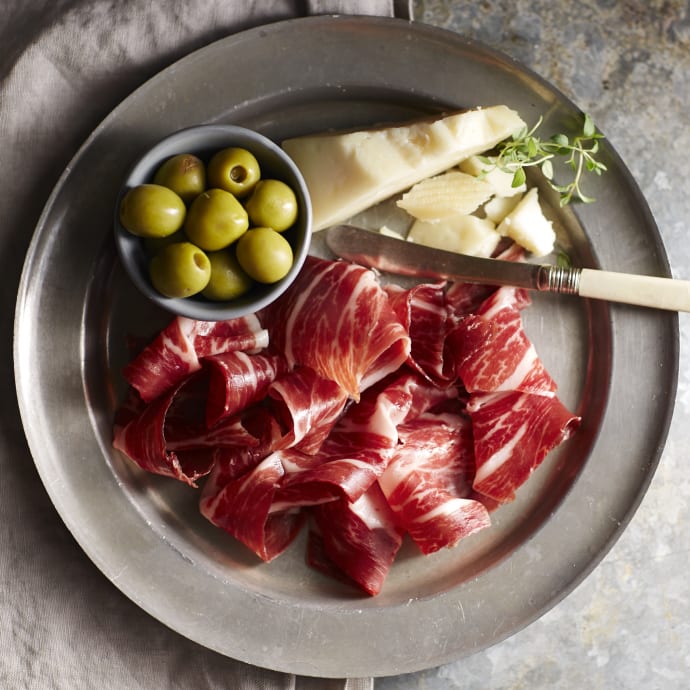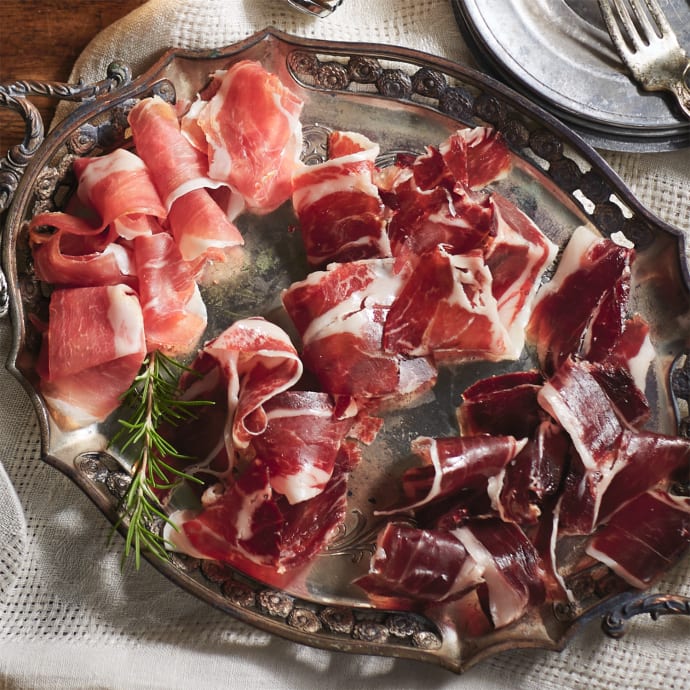Adam Goldman
The bellhop in Madrid had a confused look on his face when I handed him a bag with a black hoof sticking out it.
"What?" I asked. "It's a jamón ibérico de bellota."
The young man understood. As everyone knows in Spain, this was no mere pig. The marbled meat of the jamón de bellota is a delicacy, the granddaddy of all hams. My friends and I had been carrying one around to nibble on during a culinary trip through Spain.
"The ultimate," said Don Harris, who owns La Tienda in Williamsburg, Va., which sells a wide array of Spanish products.
A descendent of the wild boar that predates the Roman Empire, the ibérico or Iberian breed is only found in Spain. The black beasts, commonly known as pata negra or "black hoof," graze in lush mountain meadows called dehesas where they devour mushrooms and roots. The meadows are dotted with oak trees that layer the ground with acorns.
There are two types of ibérico. Jamones ibérico are slaughtered before autumn and the hindquarters are cured for two years. Sausages and a type of ham called lomo can take up to four months to cure.
But it's the bellota (acorn in Spanish) that's most prized and the most expensive. These pigs spend the fall months gorging on acorns, storing huge levels of monounsaturated fat in their muscle -- the same fat found in olive oil. During these particular months, the bellota pigs can double their size, reaching 400 pounds.
For a bellota, curing the hindquarters can last three years. Shoulders for both types of ibérico take a little less time because they're smaller and there's less fat.
Both types of ibérico are covered in sea salt for a number of days and then washed off and put in a cellar to dry. As a result, ibérico hams are less salty than, for example, proscuitto hams, which are hand-salted and slathered in lard, or smoked Virginia hams.
Neither type of ibérico has ever been available in the U.S. But that's about to change, said Taylor Griffin, president of The Rogers Collection, an importing company based in Portland, Maine.
Griffin and the well-known Spanish chef Jose Andres, who has popular restaurants in Washington, D.C., have teamed up to bring the famous hams to the U.S.
"Jose Andres, he's really helped get this whole thing going, convincing the producer it was worth doing," Griffin said.
At the moment, their company, called Fermin USA, is the only approved importer of the ibérico ham, Griffin said. Embutidos y Jamones Fermin in Spain is raising the pigs and exporting them to the U.S. Griffin said in July 2005, the U.S. Department of Agriculture approved an ibérico slaughterhouse in La Alberca, near Salamanca. Last year, some ibérico sausages and lomo were imported into the country, but the shipments were halted after a series of bureaucratic glitches.
Griffin said by the end of the year, all ibérico products -- except for the bellota -- will become available in the U.S. People will have to wait for the bellota until July 2008, Griffin said. Prices will be steep for both products. In the store, a pound of bellota will run about $160, he said. The ibérico will retail at about $85 a pound. (The one we bought in Madrid weighed about 11 pounds and cost $130).
But finding the hams won't be easy. At La Tienda in Williamsburg, customers had to put down a $250 deposit to get the first of these savory pigs. "We've got hundreds of people waiting," said Harris.

 SHIPS FREE
SHIPS FREE








